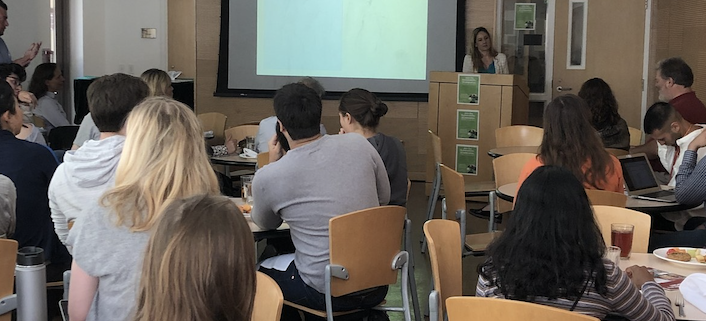Solar panels, sustainability discussed at ESA forum

The Environmental Student Assembly held its annual Spring Sustainability Forum at Parkside Performance Cafe Wednesday. Nearly 40 students, faculty and staff members attended the event, which marked the first official planning session for the University’s Sustainability 2028 Plan.
The forum focused on four major sustainability areas —energy, water, waste and transportation — and informed attendees about USC’s progress in each, as well as the state and city regulations the University is required to follow.
Ellen Dux, the Office of Sustainability’s only paid employee, programmed the event. She deemed it a “home run,” citing the large turnout and high level of audience engagement on all four topics.
“When I started a year ago, collectively everybody said, … ‘The University doesn’t care about sustainability,’” Dux said. “We should be getting as many people from this University community to understand what we’re doing, what we’re not doing and why we should be doing more of it — and caring about it.”
Dux emphasized the need for student engagement in sustainability. The Office’s 2028 Plan survey also launched Wednesday, which she said is the most effective way for the community to effect change in the University’s approach to sustainability.
Facilities Management Services Energy Manager Zelinda Welch gave the first presentation, discussing USC’s current energy usage and how it will change in the future.
Welch listed a number of state and city regulations that apply to USC, including State Senate Bill 100. Passed last August, SB 100 accelerates the state’s energy efficiency goals, eventually leading to 100% renewable or carbon-free energy across California by 2045.
According to Welch, 30% of the energy USC currently uses is drawn from renewable sources, which is solely due to the renewable energy sources that have been provided by the Los Angeles Department of Water and Power.
According to the Office of Sustainability’s website, USC operates small-scale solar installations only at a couple off-site facilities. The University Park Campus’ renewable energy efforts rely primarily on energy-efficient lighting systems and a water-chilling tank of 3 million gallons located under Cromwell Athletics Field. The tank serves over 70 buildings on campus.
Mark Malan, an accounting technician in the Provost’s office, asked Welch about the University’s reluctance to incorporate solar power into its renewable energy efforts.
Historically, USC has said that solar energy is not as effective or cheap as other options, according to multiple attendees. The Office of Sustainability’s website lists seven reasons to not incorporate solar energy. One reason is that many buildings cannot physically support solar installations, which would take up about 10% of any given building’s energy needs if installed.
“I’d be very excited to see solar on the campus,” Welch said. “Energy efficiency projects, in many ways, make more sense before you get to solar.”
According to associate history professor Joshua Goldstein, who attended the forum, students and faculty have been pushing for an off-site solar system at Galen Center for at least six years. He said students brought in workers from EcoMotion, a sustainability solutions company, for a consultation to assess the feasibility of installing solar panels on top of the center.
According to a 2015 post on EcoMotion’s website, USC actually hired the company, but Goldstein was not sure about the details of why the plan eventually fell through.
“The roof is one of the best for solar that EcoMotion solar experts Strand, Ware and Lowell-Britt have ever seen,” the website read.
The Daily Trojan previously reported that students from ESA’s Environmental Core formed a USC Go Solar campaign in 2014, which held multiple rallies and garnered hundreds of signatures on petitions demanding that USC install solar panels on- and/or off-campus. The last rally was held in November 2017, according to Environmental Core’s Facebook page.
Karen Reed, an FMS program manager, spoke about the University’s efforts in water conservation. She said the University formed a water conservation task force in response to the California drought, which drove former Gov. Jerry Brown to issue a state of emergency in 2014.
Reed said that since 2015, USC Housing has installed nearly 6,800 low-flow fixtures that significantly reduce water usage in on- and off-campus housing. She said FMS has identified 1,200 fixtures — faucets, toilets and showerheads — in non-housing buildings to eventually replace, as well.
According to Reed, as of January, USC has completed all of the main infrastructure required to begin using recycled water for irrigation and cooling towers, which she said will save the University around 19% in savings. She said LADWP estimates a delivery date sometime in 2024 for the water to be used.
Administrative Operations Executive Director Mark Ewalt, who oversees the Office of Sustainability, cited this infrastructure, which he referred to as the “purple pipe,” as an example of a sustainability effort employed by the University that was not mandated by the city or state.
“That’s something that we took on our own because we knew that’s the best way to spend money for water reduction,” Ewalt said.
Multiple campus sustainability leaders said the appointment of President-elect Carol Folt, an environmental scientist, has made them hopeful about USC’s future. In Fall 2016, Folt launched the “Three Zeros Environmental Initiative” at the University of North Carolina at Chapel Hill. According to the University’s website, the initiative moves the campus toward water and gas neutrality, as well as zero waste production.
ESA co-director Nathaniel Hyman said Folt’s appointment has stimulated a new sense of optimism throughout ESA and other sustainability groups on campus.
“If we can match the newfound optimism … with student body engagement, that will send the message to the Board of Trustees that we’re serious,” Hyman said. “For years, we felt like we were screaming into the wind … because our sustainability efforts are brand new.”

